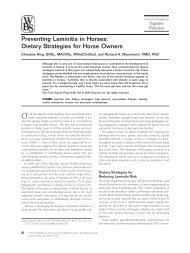Nutritional Secondary Hyperparathyroidism in the Horse
Nutritional Secondary Hyperparathyroidism in the Horse
Nutritional Secondary Hyperparathyroidism in the Horse
You also want an ePaper? Increase the reach of your titles
YUMPU automatically turns print PDFs into web optimized ePapers that Google loves.
Scru<strong>in</strong> Phosphorus, Calciiiiii, and Alkal<strong>in</strong>c l’hosphatnsc 73<br />
as <strong>the</strong> product of calcium and phosphorus is concerned, an /iiidwsut/irated<br />
serum. There is no reason to expect that a primary decrease <strong>in</strong><br />
ei<strong>the</strong>r ion would <strong>in</strong>crease <strong>the</strong> o<strong>the</strong>r. On <strong>the</strong> o<strong>the</strong>r hand, a primary<br />
<strong>in</strong>crease <strong>in</strong> ei<strong>the</strong>r ion will decrease <strong>the</strong> o<strong>the</strong>r when <strong>the</strong> saturation po<strong>in</strong>t<br />
is reached. Experimental hyperparathyroidism due to hypocalcemia<br />
follow<strong>in</strong>g excessive phosphorus feed<strong>in</strong>g with cont<strong>in</strong>uous analyses of<br />
serum calcium and phosphorus has been reported <strong>in</strong> <strong>the</strong> sw<strong>in</strong>e and rat.<br />
LIEGEOIS and DERIVALJX (1951) fed pigs diets with calcium to<br />
phosphorus ratios vary<strong>in</strong>g from 1 : 5.5 to 1 : 11.6. Serum phosphorus<br />
rose from <strong>the</strong> second week through <strong>the</strong> fifth week and <strong>the</strong>n fell to and<br />
rema<strong>in</strong>ed with<strong>in</strong> normal range. At <strong>the</strong>ir height serum phosphorus<br />
levels of close to 11 mg. per 100 ml. were recorded as compared to <strong>the</strong><br />
<strong>in</strong>itial 6.5. Serum calcium rema<strong>in</strong>ed with<strong>in</strong> normal range for 2 or even<br />
5 weelis, <strong>the</strong>n dropped as low as 6.5 mg. per 100 ml. <strong>in</strong> one case.<br />
Normalization occurred after 7 to 8 weelis. Hyperphosphaturia occurred<br />
a short time after <strong>the</strong> highest serum phosphorus and <strong>the</strong> lowest serum<br />
calcium levels had been observed. Thisexperiment showed <strong>the</strong> <strong>in</strong>timate<br />
relationship between serum calcium and phosphorus. Excessive phosphorus<br />
feed<strong>in</strong>g resulted <strong>in</strong> hyperphosphatemia and, after some ddq,<br />
dur<strong>in</strong>g which period saturation of serum occurred, serum calcium fell.<br />
Once <strong>the</strong> hyperparathyroidism was <strong>in</strong>duced by hypocalcemia, <strong>the</strong><br />
effects of <strong>in</strong>creased parathyroid hormone levels <strong>in</strong>fluence <strong>the</strong> relationship<br />
between serum calcium and phosphorus, i.e. release of bone<br />
m<strong>in</strong>eral, <strong>in</strong>creased solubility of calcium and phosphorus <strong>in</strong> blood<br />
serum, and <strong>in</strong>creased renal excretion of phosphorus.<br />
Supersaturation does not <strong>in</strong>validate <strong>the</strong> law of constant ion product.<br />
In later stages when hyperphosphatemia is partly or completely<br />
compensated for, or even overcompensated for, <strong>the</strong> ion product may<br />
not reach saturation. Changes <strong>in</strong> one ion are <strong>the</strong>n not reflected <strong>in</strong> <strong>the</strong><br />
o<strong>the</strong>r, but this, of course, does not contradict <strong>the</strong> reciprocity of calcium<br />
and phosphorus <strong>in</strong> a saturated solution.<br />
ENGFELDT et al. (1 954) <strong>in</strong>duced secondary hyperparathyroidism <strong>in</strong><br />
rats by feed<strong>in</strong>g diets with excessive amounts of phosphorus <strong>in</strong> proportion<br />
to calcium. They stated, “In our experiment it has not been possible<br />
to confirm <strong>the</strong> existence of a direct correlation between <strong>the</strong> content of<br />
calcium and phosphorus <strong>in</strong> <strong>the</strong> diet and <strong>the</strong> concentration of <strong>the</strong>se<br />
substances <strong>in</strong> <strong>the</strong> blood. Fur<strong>the</strong>r, it can be concluded that <strong>the</strong>re is no<br />
<strong>in</strong>verse relationship between <strong>the</strong> blood-calcium and <strong>the</strong> blood-phosphorus,<br />
as has, previously, been po<strong>in</strong>ted out by o<strong>the</strong>rs”. Morphologic<br />
evidences of parathyroid hyperactivity were observed <strong>in</strong> rats after 60<br />
Downloaded from<br />
vet.sagepub.com by guest on April 14, 2010



